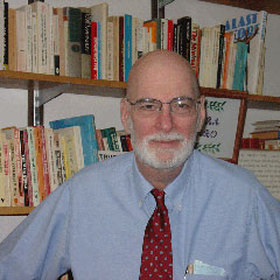 Professor Frederick Krantz Isranet Editorial, December 24, 2013 Canadian Institute for Jewish Research The American Studies Association’s embrace of “BDS” restrictions against democratic Jewish Israel has been condemned in many quarters. That it is based on ignorance, hypocrisy and implicit anti-Semitism goes almost without saying; that the motion was passed by a small voting minority of the 5,000- member association is less known. But what concerns me here are the implications of its action as a professional academic group, which raise questions about the appropriateness of professional associations and other corporate groups, and above all universities, taking overt political positions. As a professional association, the ASA's primary purpose is to promote the professional concerns of its academic members, not to take highly ideological and politicized public positions (which--as in the case of this group--often do not in any case represent the majority of their members: only ca.40% of the ASA membership voted, and of that group, over a third, I gather, opposed the motion, meaning a minority of the overall membership determined its policy). But the key issue, nevertheless, isn't whether a clear majority did, or didn't, support the ASA's action. It is about whether it is appropriate for academic entities--colleges and universities, and the Faculties and departments which compose them, as well as professional academic associations-to take public political positions binding on all their members. In terms of these unique institutions, the key consideration, and principle, must be respect for academic freedom (as the American Association of University Professors, in opposing academic boycotts of any kind, has affirmed). Above all, care must be taken not to violate the rights of individual faculty members. As importantly, we are citizens before we are "faculty", and as such our primary political arena--within which political action is not only legitimate, but incumbent on us, and where rights and freedoms are guaranteed by constitutions, human rights charters and civil law--is not the university or professional association, but the state, or "society", generally. Anna Blech won first prize at the New York City History Day competition for her research paper, "Downplaying the Holocaust: Arthur Hays Sulzberger and The New York Times." For this paper, she also was awarded The Eleanor Light Prize from the Hunter College High School Social Studies Department and membership in the Society of Student Historians. 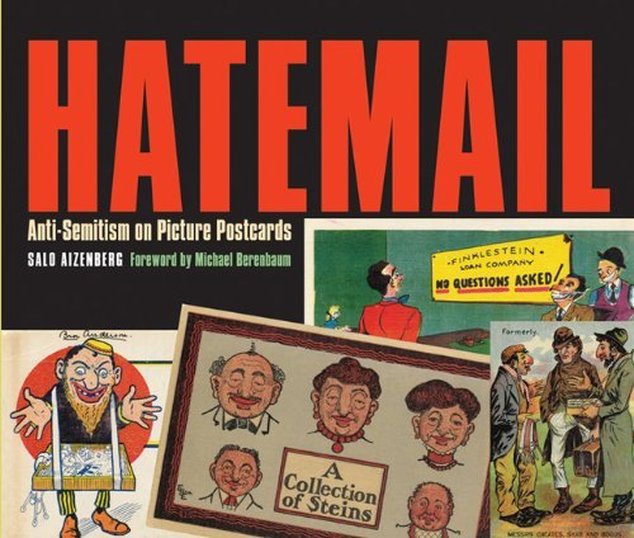 Tablet Magazine, December 12, 2013 A newly published collection reminds that grotesque images of Jews were routinely mailed by ordinary people around the world. The following is excerpted from Hatemail: Anti-Semitism on Picture Postcards by Salo Aizenberg and Michael Berenbaum. The first anti-Semitic postcards were issued in the 1890s at the same time that postcards in general were becoming popular. In fact, there was a convergence between the start of the Golden Era and the Dreyfus Affair. In this famous incident that began in 1894, Alfred Dreyfus, a patriotic French army captain, was falsely accused of passing military secrets to the German military attaché in Paris. Even though there was no visible motive and all the evidence was circumstantial, the blame was laid on Dreyfus for one reason: his Jewish heritage. Dreyfus was convicted in 1895 in a sham trial that featured “secret” evidence that Dreyfus’ lawyer was not allowed to examine; the army invoked national security as a reason to keep the documents hidden. Even after the army became aware of the real spy and of the fact that some of the evidence against Dreyfus had been forged, Dreyfus was reconvicted in a second trial held in 1899 (after he had spent four years in harsh prison conditions on Devil’s Island). Fortunately, Dreyfus was pardoned by the French president 10 days after his second conviction, but he was still not exonerated. Only in 1906 did the court declare him completely innocent. The Dreyfus Affair reached deep into French politics and society, splitting the nation between those who supported nationalism, the church, and a military that spared no effort to continue the cover-up; and intellectuals, progressives, and a small handful of brave politicians and army officials who wanted to learn the truth and promote an equal society. Underneath the drama was the unmistakable anti-Semitic nature of the affair and its influence on the fate of the entire nation. The Dreyfus Affair was also important as one of the factors that influenced Theodor Herzl, the founder of the Zionist movement, to determine that anti-Semitism could not be eliminated and that the Jews needed their own homeland. The affair still resonates, with new books written each year about the incident and its relevance to current events. The Dreyfus Affair was the perfect subject for postcards at the time, since it included all types of sensational events, such as political scandals, forgeries, a suicide, arrests, and, of course, anti-Semitism. The postcards shown in Hatemail cover multiple nations, every stereotype, and every form of hatred. They depict Jewish men, women, and children with large noses, grotesque feet, deformed bodies, ugly faces, and poor hygiene; money-hungry Jews; rich, crafty, cheap, and cunning Jews; Jews in control of the world; Jews as animals and demons; and Jews as cheaters. They show Jews being ridiculed, mocked, attacked, excluded, and expelled. The reader will not be spared the full extent of the hatred; I believe many will be shocked at what is shown in this book. Even readers who have previously studied anti-Semitism and its messages might be surprised to realize the evil that could be placed on a simple postcard and widely used around the world by “regular” people living in what were considered to be enlightened democracies. Germany, France (including its North African territories that had significant Jewish populations), Great Britain, and the United States were the leaders. Austria, Hungary, and Poland were also key participants. Fewer examples are found in other nations, not necessarily because anti-Semitism was weaker, but because postcards were published in much fewer numbers in these locations. Each country’s postcards had a distinct style of anti-Semitism. As mentioned, Germany ranked first in anti-Semitic postcards, producing images that immediately cut to the heart of the matter: Jews are filthy animals that deserve to be persecuted, expelled, and excluded from society. French postcards were a close second in their vileness. Images of Jews in control of the world or as evil or ugly money grabbers are the main motifs in French anti-Semitic postcards. Those from other nations, especially Great Britain and the United States, were sold almost exclusively as “humorous” souvenirs—but the anti-Semitism was still palpable. British anti-Semitic postcards generally avoided the worst forms of imagery, instead focusing on large nosed Jews as conniving and money-hungry. American anti-Semitic postcards are the least virulent, focusing almost entirely on images of Jews being greedy. American postcards also ridiculed the physical features of Jews, drawing not only large noses, but also large hands and awkward mannerisms. The postcards in this book all come from my personal collection, which I have been amassing for the last 10 years. The more than 250 examples depicted here are only a small sample of the many thousands of different types that were printed, but they will take the reader through the many permutations of hatred for Jews and help us to better understand a phenomenon that still exists throughout the world today. Copyright © 2013 by The Board of Regents of the University of Nebraska. Published by University of Nebraska Press as a Jewish Publication Society book. All rights reserved. 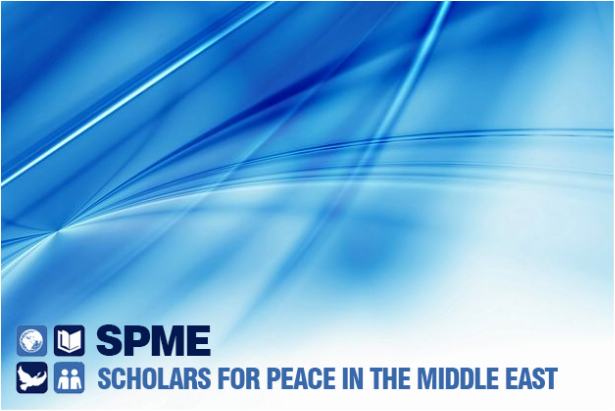 By Yehonatan Tommer & Tzvi Fleischer Scholars for Peace in the Middle East, May 6, 2007 The “New Antisemitism” is not about criticism of Israel but demonisation. The statistics are damning. Antisemitic incidents are up nearly 50% in one year. They have increased seven-fold since 1989. Moreover, racist assaults on Jewish individuals nearly doubled globally in a single year. Most of the increase came in Western Europe, but Australia was also a major part of this worrying trend – with incidents up 47% over the annual average and the number of violent attacks up more than three-fold. These are the findings of the most recent global study of antisemitism, Antisemitism Worldwide 2006, put out by Tel Aviv University’s Stephen Roth Institute for the Study of Contemporary Antisemitism and Racism. (For the full report, see http://www.tau.ac.il/Anti-Semitism/ ). Many experts argue that this massive increase in anti-Jewish racism and violence is not simply part of a new wave of antisemitic incidents, but associated with a new kind of antisemitism. This “New Antisemitism”, combining an increasingly violent demonisation of Israel and Zionism by elements of the international left, and the growing presence in Western societies of radicalised Muslim minority elements, has been widely discussed in recent years. In view of both the frightening international statistical trend in antisemitism and the international controversy about the nature and origins of the “New Antisemitism”, AIR sought out three of the world’s top experts on the subject. Below are our exclusive interviews with Prof. Dina Porat, who heads the Stephen Roth Institute at Tel Aviv University responsible for the study noted above, Prof. Robert Wistrich, director of the Vidal Sassoon International Centre for the Study of Antisemitism at Hebrew University and author of the classic study Antisemitism: The Longest Hatred, and Prof. Yehuda Bauer, internationally renowned Holocaust scholar and authority on racism and totalitarianism. *****  (JTA) — A Romanian public broadcaster distanced itself from a Christmas carol celebrating the Holocaust that aired on the new channel. TVR3 Verde, a television channel for rural communities, presented the carol on Dec. 5 during its maiden transmission. Sung by the Dor Transilvan ensemble, it featured the lyrics: “The kikes, damn kikes, Holy God would not leave the kike alive, neither in heaven nor on earth, only in the chimney as smoke, this is what the kike is good for, to make kike smoke through the chimney on the street.” In a statement Tuesday, TVR3 said it did not select the carol but only broadcast songs that were chosen and compiled by the Center for Preservation and Promotion of Traditional Culture, which belongs to the western county of Cluj. TVR considers the selection “an uninspired choice and therefore notified the Cluj County Council of this,” the broadcaster’s statement read. MCA Romania, a local watchdog on anti-Semitism, has written to Romanian President Traian Basecu and to Prime Minister Victor Viorel Ponta, to complain about the broadcast. “We are shocked to see that the Romanian Public Television Channel 3 broadcast an anti-Semitic Christmas carol,” Maximillian Marco Katz and Marius Draghici of MCA Romania wrote in the letter. “It is outrageous that none in the audience took a stance against the anti-Semitic Christian carol that incites to burn the Jews.” They added it was “absolutely unacceptable that TVR 3 tried to deny responsibility” by claiming it was the responsibility of Cluj County. 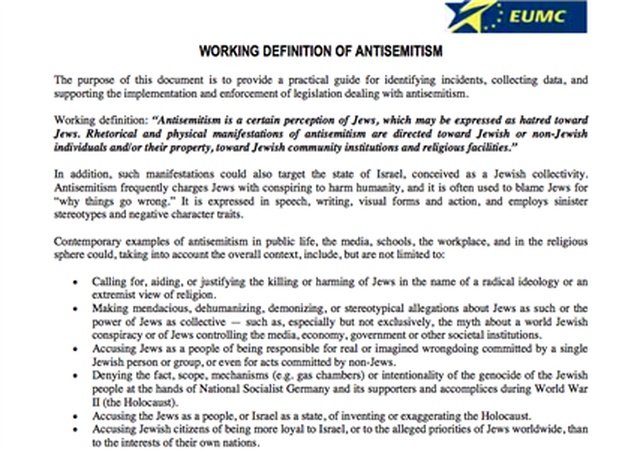 By Andreea Teoharescu, European Jewish Press, November 29, 2013 BRUSSELS (EJP)---Jewish groups have criticized the recent removal of the ‘’Working Definition of Anti-Semitism’’ from the website of the Vienna-based Fundamental Rights Agency (FRA), the European Union agency tasked with providing advice to the member states on fundamental rights of people living in the EU. The ‘’Working Definition of Anti-Semitism’’was drafted in 2004 on the initiative of the European Union’s Monitoring Centre on Racism and Xenophobia (EUMC), the predecessor of the FRA, and was considered a major achievement for the EU in the struggle against anti-Semitism. The document was created in order to provide a practical guide for identifying incidents, collecting data and supporting the implementation of legislation dealing with anti-Semitism at a European level. It was disseminated on the FRA website and units of the Organization for Security and Cooperation in Europe (OSCE) concerned with combating anti-Semitism also employ the definition. The US State Department’s yearly report, ‘Contemporary Global Anti-Semitism,’ makes use of this definition for the purpose of its analysis. Earlier this year, the EU’s ''Working Definition of anti-Semitism'' was used in Britain in a complaint relating to the BBC coverage of comments about Israel made by a British member of te Parliament, David Ward. The BBC Trust, the public broadcaster’s governing body, first upheld the definition in characterizing Ward’s comments as ‘anti-Semitic’ but later reversed its ruling following the removal of the Definition from FRA’s website. In a communication to BBC last month, a press officer at the FRA explained that the ‘’Working Definition of anti-Semitism’’ was a ‘’discussion paper’’ which ‘’was never adopted by the EU as a working definition, although it has been on the FRA website until recently when it was removed during a clear out of “non-official” documents. The removal is seen as ‘’wrongful’’ by the European Jewish organizations who are calling for the republication of the paper. The European Simon Wiesenthal Center, a global Jewish human rights organization that confronts anti-Semitism in the world, has called on the High Representative of the European Union for Foreign Affairs and Security Policy, Catherine Ashton, to launch an investigation into the disappearance of the Working Definition. Arguing that the FRA carries responsibility for the documents of its predecessor, Shimon Samuels, the Centre’s Director for Internatonal Relations, also asked to return the Definition to the current FRA website and to ensure that the appropriate EU bodies endorse it in its entirety. Shimon Ohayon, a member of the Knesset, Israel’s parliament, who chairs the Knesset Lobby for the Struggle against Anti-Semitism, told a visiting delegation of the European Parliament that Europe needs to deal more seriously with the rise in anti-Semitism and hatred. He highlighted that there are many anti-Semites who have been fighting against the ‘Working Definition of Anti-Semitism’ for many years so they can continue their attacks on Jews and Israel. ‘’Europe needs to deal more seriously with this rise in hate which is creating an untenable situation for the Jews of Europe. However, to really fight anti-Semitism, the European Union first needs a fundamental definition which law enforcement agencies and judicial bodies can use to prosecute those who target Jews and Jewish institutions,’’ Ohayon told the MEPs. The European Jewish Parliament (EJP) has joined other Jewish organizations in their efforts. “The Fundamental Rights Agency released a report about anti-Semitism two weeks ago, but there is a lack of coherence between the publication of this report and the deletion of the Definition of anti-Semitism. It is like identifying a disease and afterwards throwing the medication away”, said Joel Rubinfeld, Co-Chairman of the EJP. Contacted by the European Jewish Press about the issue, a FRA official in Vienna confirmed what the body told earlier to the BBC and said : ‘’We don’t foresee adding the working definition to our webpage. The FRA is not a standard-setting body and creating definitions is not part of our mandate. The EUMC working definition of antisemitism is not an official EU definition and has not been adopted by FRA.’’ 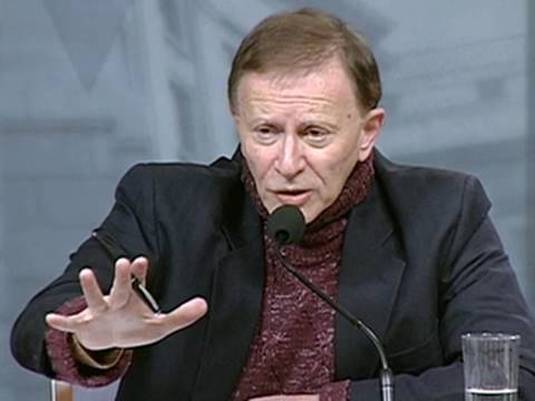 Arutz Sheva, December 10, 2013 Interview with Robert Wistrich, Rector of Center for the Study of Antisemitism: "Antisemitism is by no means the sole province of the ignorant and uneducated." “Anti-Semitism among the intellectual elite of pagan antiquity began in Alexandria more than 2,000 years ago. This type of anti-Semitism – particularly among higher cultures, i.e., Egypt, Greece and Rome – focused on issues which seem to have a perennial resonance. In particular, the charge was made that Jews were anti-social. They did not eat and drink with their neighbors as was part of the Mediterranean ethos. This ancient accusation of exclusivism and isolationism of the Jews has provided an infrastructure upon which various more serious charges have been built over the millennia. “The anti-Semitic role of intellectuals continued throughout the centuries. The fathers of the church, particularly in the fourth century of the Christian era, laid the ideological infrastructure from which much of the demonizing of Jews, Judaism, and the Jewish people developed. They explicitly branded the Jews as Christ-killers, a deicidal people. This already has its beginnings in the gospels. The only intellectuals in Christian Europe during the Middle Ages were clergymen. For over a thousand years, many leading Christian theologians taught contempt toward the Jewish people. After World War II, French Jewish author Jules Isaac described this in detail.” Professor Robert Wistrich holds the Neuberger Chair for Modern European and Jewish History at the Hebrew University of Jerusalem. Since 2002, he has been director of the Vidal Sassoon International Center for the Study of Anti-Semitism at that university. “The perception of the allegedly satanic character of the Jews continued throughout the Middle Ages. Later in that period, the Jews literally became a ‘demonic abstraction.’ Almost all their actions were interpreted as being of extraordinary malice and perversity. Church reformer Martin Luther, was a man of considerable intellectual power. His denunciations of Jews are among the most violent in the history of anti-Semitic defamation. “In the Catholic, Eastern Christian Orthodox and Protestant worlds, anti-Semitism became a widespread phenomenon. The Jews were defined by the churches as the ‘agents of the devil,’ and enemies of the faith. This demonization carried over into a rationalist, post-Christian ethos, acquiring a new secular vitality. For instance, the 18th century Enlightenment inscribed on its banners the revolt against the established church. It proclaimed the sovereignty of reason, humanity and universal ‘toleration.’ Yet it continued in the earlier anti-Semitic tradition. Its intellectual proponents turned their anti-Semitism against the Catholic Church itself. It was the Voltarian approach to the citadels of ‘superstition’ and in particular that of the Catholic Church and the Holy Scriptures. This included a total attack on the Hebrew Bible, the Jewish people, and Judaism as the source of everything that was wrong. He and other 18th century French philosophers proclaimed that the capital crime of the Jews was that they had invented God and monotheism, the worst thing that had ever happened to civilization. In other words, their sin was not having crucified Christ, but having given birth to him. “The great German idealist philosophers of the 18th century, from Kant through Fichte and Hegel, were all anti-Semitic. So were the outstanding intellectuals who followed or opposed them, such as Schopenhauer, Nietzsche and the young Karl Marx. Nietzsche and Kant were less anti-Semitic than others. This tradition climaxed with Martin Heidegger, who many people consider the 20th century’s leading philosopher. His commitment to Nazism ran deep and affected his attitude toward Jews. “Among the heirs of the Enlightenment traditions were the early French Socialists of the 19th century. With rare exceptions, they laid the groundwork for late 19th century French anti-Semitism. They included Charles Fourier, Pierre-Joseph Proudhon – founder of anarchism and a seminal figure in the French labor movement – and Alphonse Toussenel. The leading figure of French anti-Semitism at the time of the Dreyfus Affair was semi-intellectual Edouard Drumont, author of the best-selling work La France Juive (Jewish France). With approximately 100 editions, it out-sold all other books of the day in Fin-de-siècle France. “Proudhon’s great rival and antagonist Karl Marx penned a work that Marxists always include in the pantheon of his writings, "Zur Judenfrage" (On the Jewish Question). Among the many pearls of intellectual inspiration in this work, one finds phrases like, ‘Mammon is the worldly god of the Jews,’ or ‘the present Christian world in Europe and North America has reached the apex of this development and has become thoroughly Judaized.’ “Anti-Semitism is by no means the sole province of the ignorant and uneducated. Mass movements such as Nazism and many forms of fascism, nationalism, and some types of socialism do have major components of anti-intellectualism. Yet these movements which are both anti-intellectual and anti-Semitic also have an intellectual basis. Among the inspirers of European fascism were thinkers like George Sorel, Giovanni Gentile, Ernst Jünger, Oswald Spengler and many others. ‘Hitler's Professors’, to use Max Weinreich's phrase, helped prepare the ground for Nazi genocide of the Jews. “The intellectual demonization of Jews continues until the present despite sweeping changes which have taken place intellectually, socially and politically in European history. Anti-Semitism is by no means the sole province of the ignorant and uneducated. Many writers, artists, prominent journalists and academics are in the forefront of making odious comparisons of Zionism to Nazism and Israel to Hitler’s Germany. Portuguese Nobel Prize-winner Jose Saramago was just one of many. Yet they all fit into a lengthy tradition of intellectual Jew-hatred.” |
CISA Blog
This blog provides selective critical analysis on developments in contemporary culture related to the subjects of antisemitism, racism, the Holocaust, genocide, and human rights.
|
© 2025 Canadian Institute for the Study of Antisemitism. All Rights Reserved.
 RSS Feed
RSS Feed